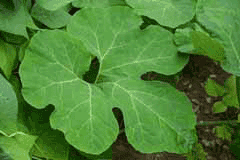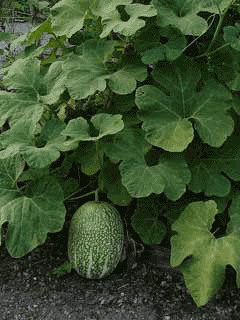 |
|
http://commons.wikimedia.org/wiki/User:Spedona |
 |
| http://flickr.com/photos/ocean_of_stars/ |
Translate this page:
Summary
Physical Characteristics
![]()
![]() Cucurbita_ficifolia is a PERENNIAL CLIMBER at a fast rate.
Cucurbita_ficifolia is a PERENNIAL CLIMBER at a fast rate.
See above for USDA hardiness. It is hardy to UK zone 10 and is frost tender. It is in flower from July to September, and the seeds ripen from August to October. The species is monoecious (individual flowers are either male or female, but both sexes can be found on the same plant) and is pollinated by Insects. The plant is self-fertile.
Suitable for: light (sandy), medium (loamy) and heavy (clay) soils and can grow in nutritionally poor soil. Suitable pH: mildly acid, neutral and basic (mildly alkaline) soils. It can grow in semi-shade (light woodland) or no shade. It prefers moist or wet soil.
UK Hardiness Map
US Hardiness Map
Synonyms
C. melanospermum.
Plant Habitats
Edible Uses
Fruit - cooked[22, 46, 61, 97]. Best used when young, at that stage it can be used like a cucumber. The mature fruits are sometimes boiled and eaten[183, 196]. A confection is made from the flesh by boiling it with crude sugar[183]. The mature fruit can be stored for 2 years or more and becomes sweeter with storage[200]. The fruit is up to 35cm in diameter[200]. Seed - raw[57, 86, 160]. Rich in oil with a nutty flavour but very fiddly to use because the seed is small and covered with a fibrous coat[K]. The seed is delicious when roasted and eaten like peanuts[183, 196]. An edible oil is obtained from the seed. It is rich in oleic acid[196].
References More on Edible Uses
Medicinal Uses
Plants For A Future can not take any responsibility for any adverse effects from the use of plants. Always seek advice from a professional before using a plant medicinally.
The seeds are vermifuge[7, 88]. The complete seed, together with the husk, is used. This is ground into a fine flour, then made into an emulsion with water and eaten. It is then necessary to take a purgative afterwards in order to expel the tapeworms or other parasites from the body[7]. As a remedy for internal parasites, the seeds are less potent than the root of Dryopteris felix-mas, but they are safer for pregnant women, debilitated patients and children[238].
References More on Medicinal Uses
The Bookshop: Edible Plant Books
Our Latest books on Perennial Plants For Food Forests and Permaculture Gardens in paperback or digital formats.

Edible Tropical Plants
Food Forest Plants for Hotter Conditions: 250+ Plants For Tropical Food Forests & Permaculture Gardens.
More

Edible Temperate Plants
Plants for Your Food Forest: 500 Plants for Temperate Food Forests & Permaculture Gardens.
More

More Books
PFAF have eight books available in paperback and digital formats. Browse the shop for more information.
Shop Now
Other Uses
The shell of the mature fruit is very hard and it can be used as a container[86].
Special Uses
References More on Other Uses
Cultivation details
Requires a rich, well-drained moisture retentive soil and a very warm, sunny and sheltered position[1]. Tolerates poor, wet and badly drained soils according to another report[160]. Plants are not very frost-tolerant, they can be grown as an annual in temperate climates, and are sometimes cultivated for their edible fruit in warmer areas of the world[50, 86]. A very vigorous plant, it can produce shoots 25 metres long in 1 year from seed in Britain[86]. This is the hardiest member of the genus but its fruits are coarse and stringy when grown in Britain so it is usually grown as an ornamental plant only[86]. Plants are day-length sensitive, flowering only in late summer and autumn[196]. This species does not hybridize naturally with other members of the genus though crosses have been made under controlled conditions[86, 135]. In America it takes 3 months from seed to first harvest and 6 months to obtain mature fruit[160]. The average fruit size is 9 kilos and this contains 2 cups of seed[160].
References Carbon Farming Information and Carbon Sequestration Information
Temperature Converter
Type a value in the Celsius field to convert the value to Fahrenheit:
Fahrenheit:
The PFAF Bookshop
Plants For A Future have a number of books available in paperback and digital form. Book titles include Edible Plants, Edible Perennials, Edible Trees,Edible Shrubs, Woodland Gardening, and Temperate Food Forest Plants. Our new book is Food Forest Plants For Hotter Conditions (Tropical and Sub-Tropical).
Shop Now
Plant Propagation
Seed - sow early to mid spring in a greenhouse in a rich soil. Germination should take place within 2 weeks. Sow 2 or 3 seeds per pot and thin out to the best plant. Grow them on fast and plant out after the last expected frosts, giving them cloche or frame protection for at least their first few weeks if you are trying them outdoors.
Other Names
If available other names are mentioned here
Native Plant Search
Search over 900 plants ideal for food forests and permaculture gardens. Filter to search native plants to your area. The plants selected are the plants in our book 'Plants For Your Food Forest: 500 Plants for Temperate Food Forests and Permaculture Gardens, as well as plants chosen for our forthcoming related books for Tropical/Hot Wet Climates and Mediterranean/Hot Dry Climates. Native Plant Search
Found In
Countries where the plant has been found are listed here if the information is available
Weed Potential
Right plant wrong place. We are currently updating this section.
Please note that a plant may be invasive in one area but may not in your area so it’s worth checking.
Conservation Status
IUCN Red List of Threatened Plants Status :

Growth: S = slow M = medium F = fast. Soil: L = light (sandy) M = medium H = heavy (clay). pH: A = acid N = neutral B = basic (alkaline). Shade: F = full shade S = semi-shade N = no shade. Moisture: D = dry M = Moist We = wet Wa = water.

Expert comment
Author
Bouché.
Botanical References
200
Links / References
For a list of references used on this page please go here
Readers comment